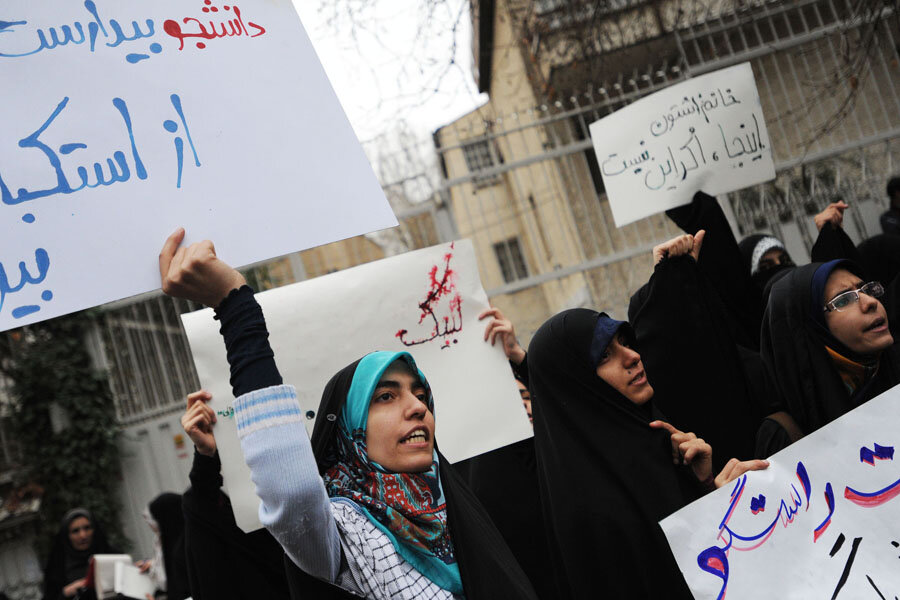EU visit to Tehran elicits accusation of political meddling
Loading...
| Tehran
The European Union's meeting with Iranian activists in Tehran has pricked hardliners' belief that human rights will be the next issue used to justify international meddling in Iran's internal affairs.
That fear prompted a small protest yesterday outside the embassy of Austria, where EU foreign policy chief Catherine Ashton met with well-known activists on International Women’s Day on March 8. For protesters, her meeting is evidence that if a nuclear deal is ever reached, other issues like human rights and ballistic missile capacity will be used to continue putting pressure on Iran.
Barely two dozen were there, chanting anti-US and anti-Western slogans in the frigid rain, prevented from even seeing the gates of the embassy by a row of Iranian diplomatic police with riot gear and shields.
Their numbers may have been small, but they have 200 conservative lawmakers behind them, an Iranian journalist noted. Ms. Ashton’s visit sparked a firestorm in parliament, where more than 20 lawmakers drew up a list of questions for the intelligence chief on how Ashton was allowed to meet “seditionists” linked to the post-election violence in 2009.
While some camps lauded Foreign Minister Javad Zarif for bringing Europe’s highest ranking diplomat to Tehran for the first time in six years, a formal complaint was issued to Austria for hosting the “unsanctioned” meeting.
The fight is part of a broader challenge to President Hassan Rouhani’s reforms. He has received a record 7,549 official warnings from lawmakers in the last 180 days.
“Now we realize the nuclear issue is a pretext for other issues; if we solve that, there will be others to pressure us,” says Mikaeel Dayyani, the head of a student group at the protest.
Mr. Dayyani cited a warning by Iran’s Supreme Leader Ayatollah Ali Khamenei earlier this year that the real purpose of the US and Europe was the overthrow of the Islamic Republic. Mr. Khamenei cited talk of imposing limits on Iran's conventional ballistic missile capacity, which did not crop up in nuclear talks for two years but surfaced during Senate questioning of lead US negotiator Wendy Sherman.
“As you can see, in recent months Sherman talked about missiles, and Ashton talked about human rights,” says Dayyani. “We should ask why they raise them, when they have ballistic missiles and they abuse human rights from Iraq and Afghanistan to Africa.”
Iranians have long bristled at accusations about human rights abuses, saying they are hypocritical and amount to foreign intervention in domestic affairs.
UN chief Ban Ki-Moon released a stinging human rights report on Iran on Tuesday, which noted “commendable steps” under Mr. Rouhani but detailed a host of problems, from a high number of executions – at least 500 last year, and 176 so far this year – to arbitrary detention. Mr. Ban noted the release of 80 political prisoners, but added that “a large number of political prisoners” including lawyers, women’s activists, and journalists remain jailed.
At the rally, placards were handed out to the protesters, one reading “Talks or interference?” which rhyme in Persian. Another sign held up by a woman in a chador asked if Ashton had met the son of one of Iran’s five assassinated nuclear scientists.
From the back of a truck mounted with loud speakers, the rhetoric was unrelenting. Ashton was excoriated for meeting “secretly” with the activists. “Lying has always been the way of the West,” went one refrain. A chant called for those who led protests in 2009 to be hanged.
The memories of the fraud-tainted 2009 presidential election, and the months of street protests and crackdowns that followed, are still raw. Many believe that the US then sought regime overthrow, and those who took part are criminals.
“In this movement, some people went with America and Ashton met people among them,” says Dayyani. Asked why reactions to 2009 should still be so potent, Dayyani countered: “Will the US forget 9/11?”








